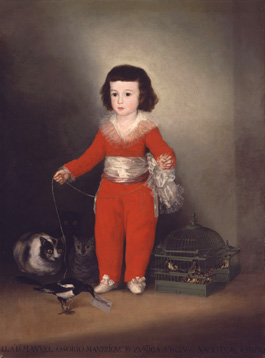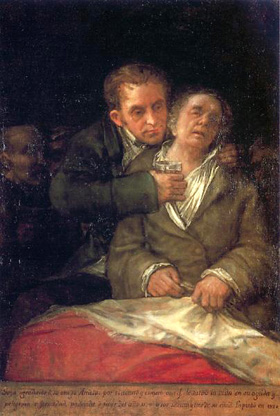Banking on Style
John Haberin New York City
Francisco de Goya and the Altamira Family
In 1787 or 1788, Francisco de Goya painted Manuel Osorio Manrique de Zuñiga—or simply The Red Boy. For a three-year-old child, he carries himself with style.
How, though, did that style enter Goya's art? And how did it become expected of of a good life, in the Style section of the papers today, along with a healthy child and a happy family? The same painter also portrayed the oldest brother, their mother and sister, and their father, Vicente Joaquín Osorio Moscoso y Guzman, the Count of Altamira. He most certainly did not portray the middle son, leaving that to a follower. Now the Met brings together the five paintings of the Altamira family. Asking which portrait came first could go a long way toward making sense of their style. 
Birds in a cage
The Met has borrowed the oldest son from a private collection, the middle son from the Cleveland Museum. The father comes from the show's co-sponsor, the Banco de España, and the mother and daughter from the Met's Lehman collection. The boy in red, though, is right at home. Regular visitors to the museum will know Manuel well from the silvery white of his broad collar, delicate sleeves, and bowed shoes, along with the broad sash around his waist. They will cherish him for his lips sharing in the glorious red of his pants suit and for his piercing dark eyes, almost of a piece with his loose brown hair. Besides, he keeps interesting company.
Nestled nicely by his feet, a green birdcage has the spired cage of a nineteenth-century gazebo in the park, and the birds within, like the goldfinch for Carel Fabritius in the Netherlands in 1654, had a reputation for their song. To Manuel's other side, cats eye a magpie with tense black and yellow eyes, and one may take a moment to spot the third and darkest cat lurking behind. The boy keeps the black and white bird on a string passing through both hands, with the steady raised arms of an impresario. One might also mention someone else in their company, at least implicitly—and not only through his artistry. The magpie, known for its wiles as a thief, holds in its lowered beak the calling card of the artist. What then does it say that a follower of Goya's, Agustín Esteve y Marques, painted an open cage and a bird taking flight on a string attached to the middle brother, Juan María Osorio?
When it comes down to it, art criticism and art history are all about how skills and ideas happen. That is why they look for a context in past influences and present circumstances. It is part of why the press is so eager to report on supposed discoveries from a young Michelangelo, although money and markets generate more than enough hype as well. It is why such details as dates and attributions matter—in short, why art takes words and and not just looking. And here the dates and ideas alike become tricky to pin down, not least because Juan died barely past infancy, in 1785, while the boy in red made it only four years past his portrait, to 1792. For those looking for intimations of despair, the countess, María Ignacia, died soon after those two sons, in 1795, and the count ended his life close to bankruptcy, in 1816, after the Napoleonic invasions.
"Goya and the Altamira Family" is about Goya as well, turning forty and at the height of his reputation. He had come to Madrid roughly ten years before, turned out sixty designs for royal tapestries, and earned such patrons as the king's brother and the prime minister. "I have," the museum quotes from a letter to a friend, "established myself in an enviable way of life"—which included being able to turn down commissions. Previous shows have covered Goya in the Met and the darkness of Goya's last paintings and Goya's prints, after illness had left him nearly blind and close to death. Here, though, he can still say that sitters will not leave him alone, "so that I do not know how I am to do it all." And therein lies the enticing puzzle of his colleague and their birds.
One wants to credit the inventions to a great painter, with the portrait of an extra brother left to others to handle as best they can. And that does not mean well. Where Goya's faces are wiser than their years and as sharp and quick as life, his colleague's portrait manages to be simultaneously flat as a pancake and bloated as an overripe melon. Goya easily creates a drama and a space around them, with a shadow behind the oldest son and light around the youngest. The gilding on a sofa or in the father's fashionably French military costume, the richly textured ribbon across his shoulder, the flowers on the mother's columnar pink dress, and the gleam on the oldest son's buckles play off against the overall sobriety—reflecting the acknowledged virtues of a simple life on a lavish estate. For the lesser painter, it is all of a piece, and the heightened perspective of floor tiles runs head first into the shallow space behind the boy's head.
It only makes sense that the portrait of the father came first, as one of six commissions between 1785 and 1788 from the bank, where the man was a director and Goya himself owned shares. Then, one might imagine, came the countess and oldest son. The boy has the powdered hair and stance, one hand across his chest and into his vest, of an heir to greatness. If the count could not rest in the end without a portrait of his lost middle son, fine. Esteve has stuck the cage on a high shelf, half out of sight, while also doing his best to make it stand for something greater. The bird is released, because so is the soul after death, and the cage bears the inscription DIOS, for god.
The invention of childhood
The curator, Xavier F. Salomon, has other ideas. He argues that the workshop effort came first, and Goya merely built on its conventions. The Spanish had little interest in commemorative portraits rather than the living. Esteve could have begun the portrait in 1785, while the child was still alive, adding the taste of death at the end. No wonder the cage ended up on a shelf. Two years later, Goya entered the picture, with the count, and things really started going. His talents shine in the differences.
 Could the show hold the secret not just to an artist and a family, but also to greatness in art? Could genius be all about learning well from others? Perhaps, but do not be so sure. The Met cannot explain how a middle son's portrait cold have come first, although the count no doubt commissioned other family pictures of its seven children, as part of a rich and growing collection. And art has had its share of memorials to the dead. Later, in his Black Paintings, Goya became more and more obsessed with death as well.
Could the show hold the secret not just to an artist and a family, but also to greatness in art? Could genius be all about learning well from others? Perhaps, but do not be so sure. The Met cannot explain how a middle son's portrait cold have come first, although the count no doubt commissioned other family pictures of its seven children, as part of a rich and growing collection. And art has had its share of memorials to the dead. Later, in his Black Paintings, Goya became more and more obsessed with death as well.
One can find plenty of interplay between past and present. Goya was not the first to sign a painting with a fictive business card—or even a bill. Yet I vote for the lesser artist, as doing his best to sum up the four paintings by the master. The dead child's birdcage even rests on a tall table with a gilded tablecloth, almost exactly the one beside the count. Goya, for that matter, could have been toying with intimations of death with the youngest son, in the dark shadows and the cats about to pounce. Probably not, since it would have taken not just a genius but a prophet, and the boy looks ever so healthy and alive, but scholars keep debating.
The debate can almost miss out on the living. Goya nurtures the contrasts dictated by convention but also by life, like the sobriety and wealth. He gives the mother a stern expression and the daughter in her arms, María Agustina, the stance of a future countess, while bringing out their intimacy. He gives the father the military bearing and clean desk of an aristocrat, along with the work habits of a banker. He gives the oldest son, also named Vincente, a pose beyond his years and the restlessness of a boy aged ten. The dog begging for his attention speaks to both.
The contradictions make Goya modern, and they do much to explain his popularity today. Sure, one can see the difference between the boy with powdered hair and the boy in red as the difference between a boy with a role to fulfill and a boy free to let his hair down. And sure, one can see the father's short stature as something that Goya did his best to hide, by keeping the count seated (and with his butt raised slightly off his chair), although the painter also used the tall canvas of a standing portrait as if to call attention to the unused space above. Mostly, though, one can see the invention of childhood and of the middle class—an aristocracy of money and virtue rather than simply birth. One can see the unpretentious side of Romanticism in art coming to be as well. Someone later added fancy inscriptions with the name and status of each sitter, but not Goya.
Family is becoming first and foremost about love, not inheritance, with the father's boyish face the mirror of the son's maturity. And childhood is becoming about play. Compare that dog climbing the oldest boy's leg, the movement of its hair so fully realized, to the dog propping up a prince's bearing, also at the Met, for Jean-Baptiste Carpeaux in France. Compare the boy in red and his gamesmanship to the adult world of Fabritius more than a century before. John Singer Sargent and his portraits of children, here we come. As for the fate of the birds, I am betting on the cats.

"Goya and the Altamira Family" ran at The Metropolitan Museum of Art through August 3, 2014. Related articles look at Goya in the Metropolitan Museum, Goya drawings and prints, and Goya's last paintings.




